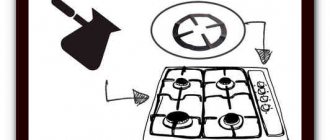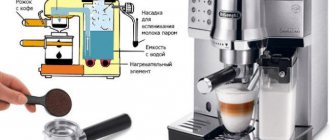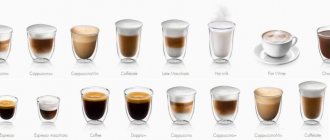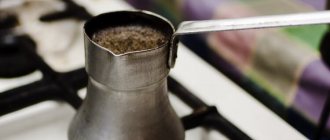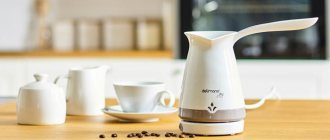Form
Sergey Blinnikov, Russian bronze medalist in preparing coffee in a cezve:
“I hope that somewhere there is a wonderful world in which everyone has the opportunity to buy the perfect cezve: solid, hand-forged, made of pure silver, with thick walls, correct geometry and a bronze handle. In our world, such a thing exists, but it costs $800. So let's look at more realistic options.
The most important thing in a cezve is its geometry, in particular the ratio of the width of the base to the width of the neck. The narrowing should be small but visible, about 20% of the bottom size.
If the neck is too narrow, the coffee tablet that forms during brewing will be too thick and only the coffee that comes into contact with the liquid will be extracted. The top of the tablet may even remain dry.
If the neck is too wide or does not exist at all, then a coffee tablet will not form on the surface. The coffee will boil uncontrollably and overbrew. If you have such a cezve, I advise you to use it for boiling eggs - it’s very convenient.”
Popular manufacturers
Coffee is truly a divine invigorating drink. For citizens, a cup of espresso in the morning is a real ritual, and for some it is a full breakfast. A properly prepared coffee drink stimulates a person to be active throughout the day. It is important not only to buy high-quality ground or instant coffee, but also to choose good utensils for the brewing process.
Ground grains contain a whole range of useful substances and antioxidants, while instant grains usually lose all vitamins during the manufacturing process.
We present to your attention the rating of the most popular purchased Turks:
- Turka “Copper”, 0.5 l. This cookware is made of copper and is coated inside with a special protective layer that prevents harmful copper substances from entering the drink when heated. This device is equipped with a rather long wooden handle, which is very convenient for pouring a drink into a mug. Among the main advantages, it is necessary to highlight the ability to prepare coffee of any type, the presence of a nose, an excellent ratio of the bottom of the Turk and its throat, good build quality, and a classic design.
This device is equipped with a rather long wooden handle, which is very convenient for pouring a drink into a mug.
- Mayer & Boch. Quite a famous Turkish woman who is popular all over the world at the moment. The product is made of copper-nickel alloy, which gives an exquisite appearance and durability. The main advantages of this kitchen utensil include excellent build quality, a long handle, uniform distribution of coffee in the container, as well as unique embossing, which gives the product a unique design.
The product is made of copper-nickel alloy, which gives an exquisite appearance and durability.
- Turk "Grace". A fairly simple popular product for brewing coffee, which is very common in the CIS countries. First of all, we should highlight the excellent price-quality ratio of this Turk. Other features include a fairly thick tin inner layer, an outer copper plating, a secure handle, a narrow neck, no engraving and a mirror-type polish. Due to this, this product is quite easy to wash and use.
It doesn’t matter which Turkish manufacturer you choose - domestic or foreign, the main thing is that your morning starts with a cup of delicious, high-quality cappuccino.
Size
Maria Trokhimenko, judge of Russian barista championships and champion of the Far East in cezve coffee:
“Choose a cezve according to the standard size of your cup, for example, 200 or 250 ml. You can also have a very small one, 90 ml, like in Turkish cafes. This volume will cook faster due to less water.
You can, of course, take a 500 ml Turk to prepare several cups at once. But all the brewed coffee needs to be drunk at once. It will not be possible to make a small portion in a large Turk: as in the case of a Turkish Turk that is too wide, the coffee head will not form and the coffee will boil quickly.”
How to care for dishes
Any Turk needs proper care so as not to damage or deform the materials from which it is made. We will bring to your attention a few basic care points.
In order to wash the internal and external parts of these kitchen utensils, you need to use only soft sponges. The use of iron brushes or other hard-coated kitchen cleaning utensils may cause damage or further deformation of the material.
In order to wash the internal and external parts of these kitchen utensils, you need to use only soft sponges.
Use only high quality detergents that are not harmful to the copper alloy of the product.
As you know, the cezve loses its metallic luster over time, so periodically do not forget to thoroughly rinse it with special products so that a thick coating does not form. The best way is a mixture of dough and table vinegar in a ratio of 10: 1. Spread the mixture on the Turk and let it dry. Then gently wipe it off under running water with a sponge.
The means for high-quality cleaning of the product from coffee scale and stove burns is a saline solution made from whey. Dissolve 1 tablespoon of salt in one glass of the last ingredient.
If you don’t want free access to the cleaning ingredients presented above, you can buy special products for cleaning Turks in the store at any time.
Take proper care of your cookware and it will serve you for many years.
Currently, there is a huge range of coffee, hence the variety of ways to prepare it. Therefore, choosing the most suitable and profitable option is easy and simple. Which one is right - a Turk or a cezve - everyone decides for himself. The main thing is to properly care for your dishes, and they will serve you for many years.
Material
Sergei Blinnikov:
“The best choice, besides silver, is copper. It conducts heat well, but does not accumulate it, so it is easy to control the process of making coffee in such a cezve, especially if its walls are thick, about 1.5 mm. It is important that the copper is internally treated with silver or food-grade tin - a material that does not enter into chemical reactions with food. But tin and silver are easily erased, so you need to wash Turks with such a coating very carefully, with your hands and water, without sponges or detergents.
The most famous silver-plated copper Turks are Soy. Participants in cezve championships most often choose them.
If you're neat, consider purchasing a quartz cezve. It shows everything that happens to coffee during the brewing process, it’s fascinating.
Ceramic cezves are quite capricious. They transfer heat unevenly and tend to accumulate it. Coffee can run away when you have already removed the Turk from the heat.”
Maria Trokhimenko:
“Clay absorbs coffee oils, so it can change the taste of coffee. It will not be possible to prepare the same drink in a clay pot two times in a row.
Don't buy an aluminum pot. When heated, aluminum reacts with the drink, changes its taste and is generally considered unsuitable for cookware.
In a stainless steel pot you can achieve relatively good results. But there is a minus - low thermal conductivity. A stainless steel pot heats up unevenly, like a saucepan, and will overheat the coffee in the bottom area. There is a risk that the drink will turn out more bitter.”
Interesting facts about the Cezve Turks
There are many funny and instructive stories associated with this dish.
- In the countries of the Middle East, the wealth of the owner could be determined by the cezve. In rich houses, coffee was brewed in silver vessels, for everyone else there was copper and its alloys, and the poor used a clay pot.
- It is believed that Turku was invented in Turkey, but this is not so. She came to this country along with coffee. The Turks simply spread the dishes around the world, again, along with coffee and their own recipes for its preparation.
- After the inventor of the cezve presented it at the court of the customer-sovereign, he, as a reward, gave the right to monopoly trade in the new product to its creator. This permission brought a fortune to the savvy vizier, who came up with the conical cezve.
- The Turks make the neck narrow so that the rising foam acts as a cork, preserving the aroma and taste of the drink as much as possible, preventing them from evaporating.
Modern containers for coffee with a wide neck are just scoops, but not Turkish cezves.
- The classic parameters of a cezve are considered to be the ratio of the diameter of the bottom and neck as 2 to 1. The bottom can be even wider, this is only for the better.
- Craftsmen have attempted to crossbreed dallu, ibrik and cezve. The resulting vessel had round, low sides, like an ibrik, a top with a narrow neck, like a cezve, and a lid, like a dalla. We were unable to find data on the quality of coffee from this dish, but the very attempt to combine all the traditions in one device deserves respect.
There are no differences between a cezve and a Turk , so call your favorite coffee device whatever you want. Treat yourself to a fresh drink brewed according to classical traditions, and may your every morning be exceptionally invigorating!
To dust or not to dust, that is the question
Sergei Blinnikov:
“Thanks to the grounds, coffee from the cezve continues to be extracted in the cup until it is completely drunk. This is both good and bad: with the right recipe and grinding, the drink will open up better and better every minute!
But there is a problem: with such a long extraction, up to 20-30 minutes, there is a great danger of overbrewing the coffee and getting extra bitterness in the taste. This needs to be taken into account when choosing the grind.
Choose according to the principle “the darker, the larger.” For example, I brewed Yemen Matari No. 4 (light roast), Brazil Irmas Pereira 36 Hour Fermentation No. 170 (medium roast, dark filter), and Honduras San Marcos No. 22 (darker than medium roast). All beans gave off enough sweetness with a coffee to water ratio of 1:8-1:9 (12 g of coffee per 100 ml of water). But Yemen opened up with an espresso grind, and for Honduras we had to take a grind that would be suitable for a Chemex. Unfortunately, with such a coarse grind, the coffee loses its body, but we remove excess bitterness from the drink. Although when brewing group B it is not possible to completely avoid bitterness - this is a dark roast.
If you don’t like grounds in your cup, filter the cezve using paper filters. The V60 funnel or AeroPress will give you a clean drink. But the thicker the layer of paper, the lighter the cup you will get.”
Requirements for a quality Turk
They differ in materials, volume, and external design. To know how to choose a good coffee pot, let’s take a look at the main parameters of this product. Characteristics of the Turks:
- Turkish type. There are conventional ones for cooking on a fire (stove) and electric ones.
- The material of the vessel on which thermal conductivity and wear resistance depend.
- Form. Ideally, it should be cone-shaped.
- Bottom thickness. The thicker the bottom, the slower the drink will heat up, gradually revealing notes of aroma.
- The size of the neck in relation to the bottom. For a proper Turk, the ratio of parameters should be 1:2, no less.
- Pen. It must contain heat-insulating material.
- Volume. It depends more on personal needs, but ideally the Turk is designed for a maximum of 2 cups of drink.
- Simplicity. The cezve itself is very simple and any intricacies do not make it better, so you shouldn’t get too hung up on them.
These are the main parameters of the product, and each user must decide which Turk to choose for themselves depending on their needs.
Spices in Turk
Sergei Blinnikov:
“If you're tired of regular coffee, don't be afraid to experiment with additives and spices. You probably have everything at home to make a cool signature drink. For example, I took second place in the championship with a recipe that used star anise, saffron and canned peaches.
The main thing is to follow the order in which the ingredients are added. Always add coffee to the bottom of the cezve. Add bulk ingredients – sugar, spices – to the ground grain. Part of the water (but not more than half) can be replaced with almost any juice; pour it over ground coffee. And only at the end add water and put on fire.
Do not use more than three ingredients, otherwise you risk losing the taste of the coffee. If you add something sour, balance it with something sweet. I do not recommend salt, black pepper and cinnamon - they kill the taste of the cezve.
Experiment, and let each new cup be a small discovery!
More on the topic: “How to improve the taste of coffee in a cezve”
First coffee utensils
The history of coffee began about a thousand years ago, and they began to brew it in hot water 8-9 centuries ago. It is clear that this required dishes. The first were unassuming kettles and saucepans, but soon the wandering Bedouins adapted special jugs - ibriks - for preparing the drink. Experts and ethnographers claim that their origin is so ancient that it evokes awe and reverence.
Ibrik
The word is of Arabic origin (according to some sources - Persian). Composed of two words - “water” and “pour”.
It is believed that it was the ibrik that became the first coffee utensils. In essence, this is a simple Bedouin jug that could be carried for travel and hold a minimal amount of liquid. Archaeologists have also found stationary ibriks that could mix up to 100 liters of liquid. Of course, coffee was not brewed in such containers, but used for water or wine.
A special feature of the ibrik was its long spout, through which it was convenient to pour hot liquid.
Another feature was the round sides, offset towards the bottom. They provided capacity and stability.
Despite its reputation, after a couple of centuries the ibrik had to make way for a new container for coffee called the dalla.
Dalla
It replaced ibrik around the time that coffee entered Arabia and significantly increased its status. It ceased to be the drink of nomads and Bedouins and confidently stepped into rich chambers.
Dalla is a tall jug with a lid and a short spout. The dishes could be very luxurious, with rich embossing. Such jugs were used in merchants' and nobles' houses. Simpler people had less intricate dalls.
The main difference between the dalla and the ibrik was not only in the shape of the spout, but also in the material of manufacture - the dalla was made of metal, while the ibrik was often made of clay, due to the poverty of its owners.
The most important difference between dalla and ibrik is its purpose. Ibrik was used for any liquid. Dalla - only for making coffee.
Arabic coffee pots appeared at least 500 years ago. They were so popular that grateful descendants even erected monuments to them. Such a monument can be seen, for example, in the UAE.
Classic cezve recipe from Maria Trokhimenko
Maria uses a Soy copper cezve.
What you will need:
- 115 g water at room temperature;
- 11 g coffee;
- grind – fine espresso;
- cooking time 2.5 min.
How to cook:
Add coffee, pour water, turn on the timer. Put the Turk on gas and stir the coffee well to break up all the lumps. This is convenient to do with a thin wooden stick.
Control the brewing time by adjusting the heat level. As soon as the coffee cap rises to the edge of the cezve, the coffee is ready. Pour it into a cup and let it breathe for another two minutes.
The advantage of a regular Turk over an electric one
The idea of an electric Turk itself is not bad. Heating occurs slowly, with a gradual increase, as expected for brewing a wonderful coffee drink. The electric device is convenient to take with you on a trip. The only downside is that most devices are made of stainless steel or plastic. And these materials are not very suitable for making perfect coffee.
Electric Turks made of ceramics will be the most optimal for those who do not want to monitor the “ripening” of the drink while standing at the stove. Although it is precisely this magical process that is the main advantage of ordinary Turks over electric ones.
The nuances of choosing a handle
Having figured out how to choose a Turk based on the type of material, you need to pay attention to the issue of selecting a handle. It should be as comfortable as possible, because during the process of brewing coffee the need for this detail arises repeatedly. In most Turks, the handle is slightly raised up, and sometimes located almost vertically.
All-metal models are not uncommon in copper, brass, and steel products. They are also made as a separate element from non-heating materials - thermoplastic, wood. Mounted in two ways:
- soldering;
- bolts.
The latter is more reliable, since the soldering breaks down over time. The handle can also be removable - plug-in or screw-on. When purchasing, you should pay attention to its location on the metal Turk. Too short a distance may cause burning.
If the choice fell on a ceramic Turk, you should give preference to cast and hollow handles.
How to choose the right Turk for an induction cooker
Not every cookware can interact with an induction cooker. For this type of plates, only those types of materials that are magnetic are suitable.
A suitable option would be steel cezves. But those who want to buy a ceramic or copper pot, but have an induction cooker at home, should not be upset. There are special conductors in the form of “pancakes” that are placed under dishes that do not conduct magnetic fluxes. The inductor recognizes a metal pancake, and when it heats up, it interacts with the dishes placed on top through normal heat transfer.

